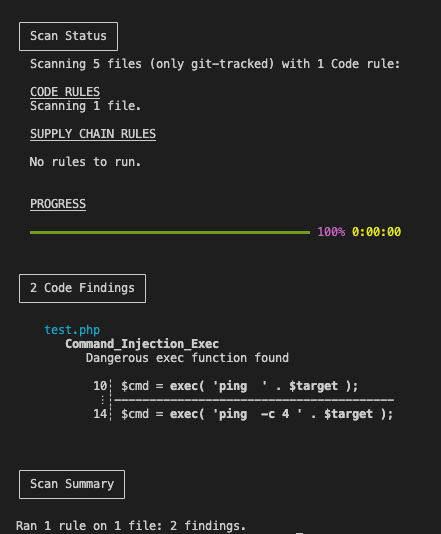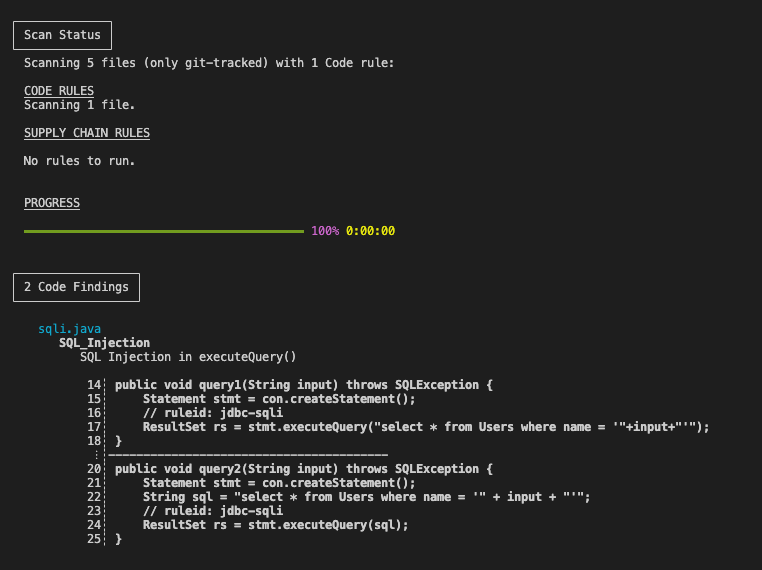3.1.1 Introduction to Semgrep
Semgrep is a powerful open-source static analysis tool that empowers developers and security professionals to efficiently identify and remediate security issues and code quality problems in their codebases. With user-friendly rules and customizable queries, Semgrep enables flexible and targeted scanning for vulnerabilities and misconfigurations, making it a valuable addition to any development or security workflow. In today’s digital landscape, automated source code scanning is essential for quickly detecting vulnerabilities, particularly injection threats and dangerous functions, thereby helping teams maintain the integrity and security of their software projects.
💉 Injection Vulnerabilities:
Automated scanning is highly effective at identifying injection threats, such as SQL injection and Cross-Site Scripting (XSS). By analyzing code patterns, it swiftly detects potential injection points, allowing for proactive remediation and protection against these widespread attacks.
⚠️ Identifying Dangerous Functions: Certain functions or APIs can introduce security risks if mishandled. Automated scans can pinpoint these risky operations—like file handling or cryptographic functions—enabling developers to implement necessary security measures.
In summary, automated source code scanning, enhanced by tools like Semgrep, is a cornerstone of modern security practices. It efficiently uncovers injection vulnerabilities and dangerous function usage, strengthening applications against evolving threats.
Let’s delve deeper into Semgrep with two practical examples.
💣 Dangerous functions in PHP
Below is the PHP file stored as test.php in our current folder.
test.php accepts a parameter called IP which is then given to the exec function for checking reachability.
<?php
if( isset( $_POST[ 'Submit' ] ) ) {
// Get input
$target = $_REQUEST[ 'ip' ];
// Determine OS and execute the ping command.
if( stristr( php_uname( 's' ), 'windows' ) ) {
// Windows
$cmd = exec( 'ping ' . $target );
}
else {
// *nix
$cmd = exec( 'ping -c 4 ' . $target );
}
// Feedback for the end user
$html .= "<pre>{$cmd}</pre>";
}
?>
Below is a simple semgrep rule in yaml format that is checking for patterns accepting any number of variables in the exec function.
rules:
- id: Command_Injection_Exec
patterns:
- pattern: exec(...)
message: Dangerous exec function found
languages:
- php
severity: WARNING
Let's try to execute this semgrep rule on test.php and check if it is able to identify presence of an exec function.
cd ~/s4cpcode/chapter3/3A/
semgrep scan -c php.yaml

As can be seen the semgrep rule does identify the exec function which is a dangerous function and we now need to manually investigate. This is extremely helpful when the code base is large as Semgrep can execute the scan very fast.
💉 SQL Injection in Java
Similarly, now we'd like to identify if semgrep can catch SQL Injection bugs in Java.
Below is the Java file which we'd like to run our semgrep rule against.
package testcode.sqli;
import java.sql.Connection;
import java.sql.ResultSet;
import java.sql.SQLException;
import java.sql.Statement;
public class Jdbc {
Connection con;
public void query1(String input) throws SQLException {
Statement stmt = con.createStatement();
// ruleid: jdbc-sqli
ResultSet rs = stmt.executeQuery("select * from Users where name = '"+input+"'");
}
public void query2(String input) throws SQLException {
Statement stmt = con.createStatement();
String sql = "select * from Users where name = '" + input + "'";
// ruleid: jdbc-sqli
ResultSet rs = stmt.executeQuery(sql);
}
}
What we need to check in this Java file for SQL Injection is that the executeQuery function must not contain a query that has been concatenated. If there is concatenation it means there is a possibility of SQL Injection.
The semgrep rule below has defined two types of patterns that are attempting to check for concatenation either in a string or directly inside the executeQuery function.
rules:
- id: SQL_Injection
patterns:
- pattern-either:
- pattern: | #executeQuery
$RETURN $METHOD(...,String $VAR, ...) {
...
$SQL = $X + $VAR + $Y;
...
$W.executeQuery($SQL, ...);
...
}
- pattern: | #executeQuery
$RETURN $METHOD(...,String $VAR, ...) {
...
$W.executeQuery($X + $VAR + $Y, ...);
...
}
message: SQL Injection in executeQuery()
languages:
- java
severity: WARNING
Let's try to execute this semgrep rule on sqli.java and check if it is able to identify SQL Injection.
semgrep scan -c sqli.yaml
